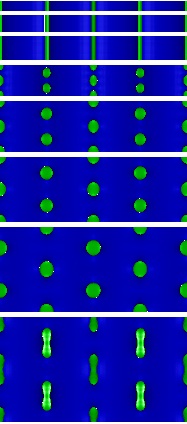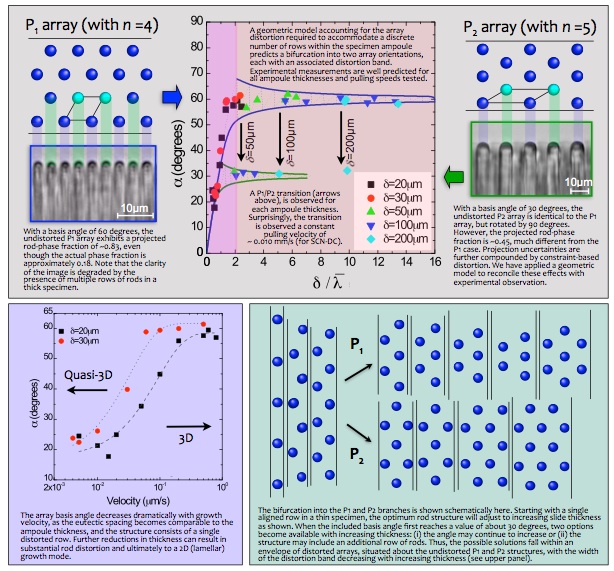ALLOY SOLIDIFICATION & PHYSICAL METALLURGY

NAPOLITANO RESEARCH GROUP
Mechanisms of the flake-fiber transition in Al-Si eutectics
The flake-fiber transition in Al-Si eutectics occurs over a range of growth velocities and involves a number of morphological features. Here, we have examined the onset of out-of-plane fiber growth from the standpoint of morphological instability, finding reasonable agreement with the scale of the periodic structures that evolve on the broad faces of the Si flakes.
T. Hosch and R.E. Napolitano, J. Mat. Sci. 44 (2009) 4892-4899. [doi:10.1007/s10853-009-3747-6]
Mater. Sci. Eng. A 528 (2010) 226-232. [doi:10.10.1016/j.msea.2010.09.008]
RECENT RESEARCH HIGHLIGHTS:
Devitrification dynamics in Cu-Zr metallic glass
We have investigated the crystallization kinetics of Cu50Zr50 amorphous alloy using in-situ high energy X-ray diffraction (HEXRD), differential scanning calorimetry (DSC) and transmission electron microscopy (TEM). Rietveld refinement methods enable high accuracy phase identification and quantitative assessment of phase fraction evolution though the duration of the observed transformations. Combined with TEM analysis, we have reveals several interesting features concerning the complex sequence of phases that appear during devitrification, involving the orthorhombic Cu10Zr7, tetragonal CuZr2 (C11b), cubic CuZr (B2), and other transition phases.
Early stage eutectic growth dynamics in rod-type eutectics
The early stage dynamics and onset mechanisms for eutectic solidification are investigated experimentally using a succinonitrile-(D)camphor (SCN-DC) transparent organic eutectic material. By specifically focusing separately on the pre-growth or holding period and the growth or pulling period, the critical roles of each in the establishment of initial conditions and the competition between eutectic initiation mechanisms are examined. It is concluded that the thickness of the single-phase layer that forms during the holding period and the prior microstructure that exists at the start of the holding period each influences the subsequent competition between eutectic formation mechanisms.
Melis Serefoglu and R.E. Napolitano, Acta Materialia 59 (2011) 1048-1057. [doi:10.1016/j.actamat.2010.10.035]
Tip selection for Si in Al-Si
Using serial milling and 3D image reconstruction, we have investigated the mechanisms that lead to the strong selection and rapid emergence of primary faceted Si bicrystalline dendritic twin-grains in directionally grown Al-Si. We have confirmed a structure for the dendritic core that includes a combination of {310} and {210} symmetric coherent twins and have described an associated twin boundary migration mechanism, at the atomistic level, which would facilitate reconfiguration of the core structure and the sideplate generation required for efficient response to radial supersaturation gradients. This type of defect mechanism promotes linear interface kinetics, which do not generally hold for faceted structures. This feature permits modeling using diffuse interface “phase-field” methods. Indeed, we have used phase-field modeling here to begin to understand the selection tip operating point for these remarkable hybrid structures. Using a 2D model, we have investigated the influence of anisotropy on the tip selection, and have found that the selection parameter (sigma-star) scales with anisotropy only up to the point where missing orientations at the tip are observed. Beyond that point, increases in interface stiffness only serve to increase the range of missing orientations, making the tip shape sharper, thereby increasing its diffusive effectiveness. This effect counters the capillarity penalty and the value of “sigma-star” becomes nearly constant.
Stages of the flake-fiber (quench modification) transition in Al-Si
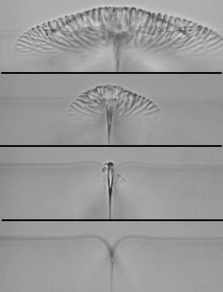
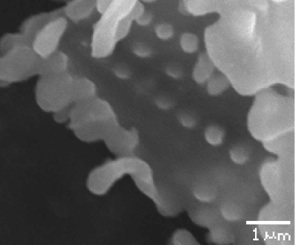
Array orientation transition in rod-type eutectic solidification
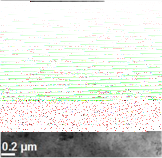

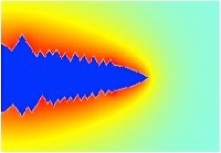
Rod eutectic growth in succinonitrile-(D)camphor is investigated experimentally using directional solidification with specimen thicknesses ranging from 20 to 200μm. Measurements in the projected plane are reconciled with a model for array distortion under the constraint imparted by the geometry, and the influence of geometry is examined with respect to the 2D array basis vectors. A transition from 3D to quasi-3D growth at very low velocity is observed, where specimen thickness becomes comparable to eutectic spacing. The principal finding is a velocity dependent but thickness independent transition in array orientation in the “bulk” regime. The transition is correlated with the dominant unstable mode in the initial SCN front, and we assert that this instability controls the array spacing along the slide wall direction. It is concluded that this type of analysis is required for meaningful interpretation of experimental results regarding rod eutectic growth, even in the apparent thick-slab or “bulk” regime.
R. E. Napolitano and Melis Serefoglu, “Control and interpretation of finite-size effects and initial morphology in directional solidification of a rod-type eutectic transparent metal-analog,” Journal of Metals 64 (2012) 68-75. [doi: 10.1007/s11837-011-0214-z]
The twinned structure in faceted bicrystalline dendrites in Al-Si
While the term "natural selection" is generally applied to the evolution ofbiological species, dynamical selection phenomena in inorganic systems may also exhibit a "Darwinian" character. During the directional growth of silicon from a binary Al-Si liquid solution, competing atomistic mechanisms at the crystal-melt interface are "selected" in accord with their ability to facilitate more efficient long-range chemical diffusion, thus promoting optimization and long-term survival of the overall morphology. At low growth rates, primary structures grow as bicrystalline faceted "dendrites", each comprised of two interpenetrating silicon twin-crystals. The dominance of this morphology suggests that the twinned structure is strongly favored in the dynamical sense. Here, we examine this selection phenomenon and propose a twin structure and associated migration mechanism, where a complex configuration of high-mobility coherent twin boundaries is the critical feature which provides the local kinetic advantage and requisite morphological responsiveness. With compelling experimental evidence to support our claim, we conclude that the observed behavior is indeed a hybrid process where mechanistic selection of the twinned bicrystal is the central enabling feature that gives rise to the morphological selection of the overall primary array structure.
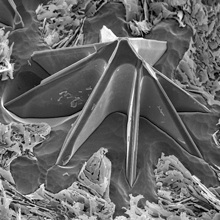
The local solidification conditions and mechanisms associated with the flake to fiber growth mode transition in Al-Si eutectic alloys are investigated here using Bridgman-type gradient-zone directional solidification. Resulting microstructures are examined through quantitative image analysis of two-dimensional sections and observation of deep-etched sections showing three-dimensional microstructural features. Several microstructural parameters were investigated in an attempt to quantify this transition, and it was found that the particle aspect ratio is effective in objectively identifying the onset and completion velocity of the flake to fiber transition, while traditional spacing parameters are not effective indicators of the transition. For a thermal gradient of 7.5 K/mm, the transition was found to occur in two stages, appearing over velocity regimes from 0.10 to 0.50 mm/s and from 0.50 to 0.95 mm/s. The initial stage is dominated by in-plane plate breakup and rod formation within the plane of the plate, while the second stage is characterized by the onset of out-of-plane silicon rod growth, leading to the formation of an irregular fibrous structure. The boundary between the two stages is marked by widespread fibrous growth and the disappearance of the remnant flake structure, indicating a transition in the structural feature that governs the relevant diffusion length, from inter-flake spacing to inter-rod spacing.
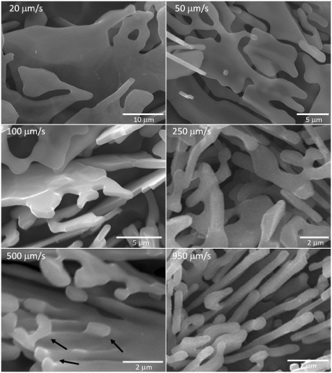
Stages of the flake-fiber (quench modification) transition in Al-Si
Solution-based thermodynamic modeling, aided by first-principles calculations, is employed here to examine phase transformations in the Al-Sm binary system which may give rise to product phases that are metastable or have a composition that deviates substantially from equilibrium. In addition to describing the pure undercooled Al liquid with a two-state model that accounts for structural ordering, thermodynamic descriptions of the fcc phase and intermediate compounds (Al4Sm-, Al11Sm3-, Al3Sm- and Al2Sm-) are re-analyzed using special quasirandom structure (SQS) and first-principles calculations. The possible phase compositions are presented over a range of temperatures, using a “Baker-Cahn” analysis of the energetics of solidification, and compared with reports of rapid solidification. The energetics associated with varying degrees of chemical partitioning are quantified and compared with experimental observations of the metastable Al11Sm3- primary phase and reports of amorphous solids. Pictured here is a Baker-Cahn plot of the candidate compositions for several competing phases at 600K (upper) and aver a range of temperature (lower). Over these ranges, the driving force for solidification was computed from the thermodynamic models.

Phase-field investigation of rod eutectic morphologies
Three-dimensional phase-field simulations are employed to investigate rod-type eutectic growth morphologies in confined geometry. Distinct solutions are found to depend on this confinement effect, with the rod array basis vectors and their included angle changing to accommodate the geometrical constraint. Specific morphologies are observed, including rods of circular cross-section, rods of distorted (elliptical) cross section, rods of ``peanut-shaped'' cross-section, and lamellar structures. The results show that for a fixed value of the basis angle, the usual (hexagonal) arrays of circular rods are stable in a broad range of spacings, with a transition to the peanut-shaped cross sectioned rods occurring at large spacings (above about 1.5 times the minimum undercooling spacing) and the advent of rod eliminations at low spacings. Furthermore, a transition from rod to lamellar structures is observed for angles less than about 10 degrees for the phase fraction of 10.5% used in the present study.
Melis Serefoglu, R.E. Napolitano, Mathis Plapp, Physical Review E 84(1) (2011) 011614. URL: http://link.aps.org/doi/10.1103/PhysRevE.84.011614, [doi: 10.1103/PhysRevE.84.011614]
